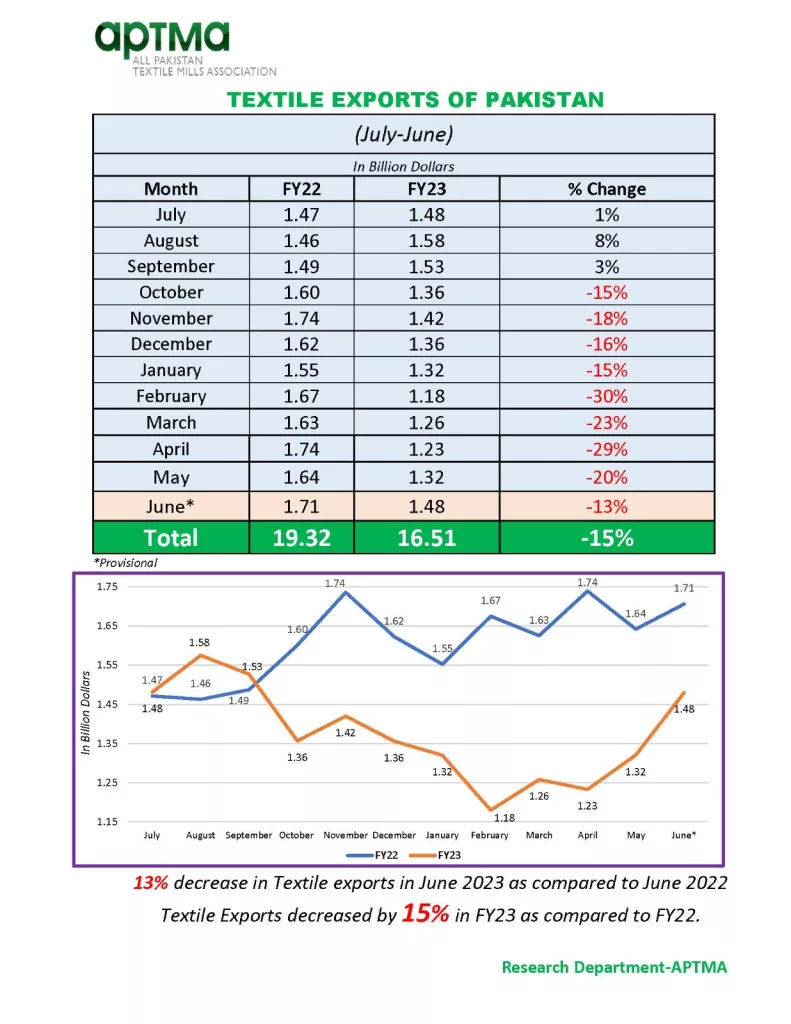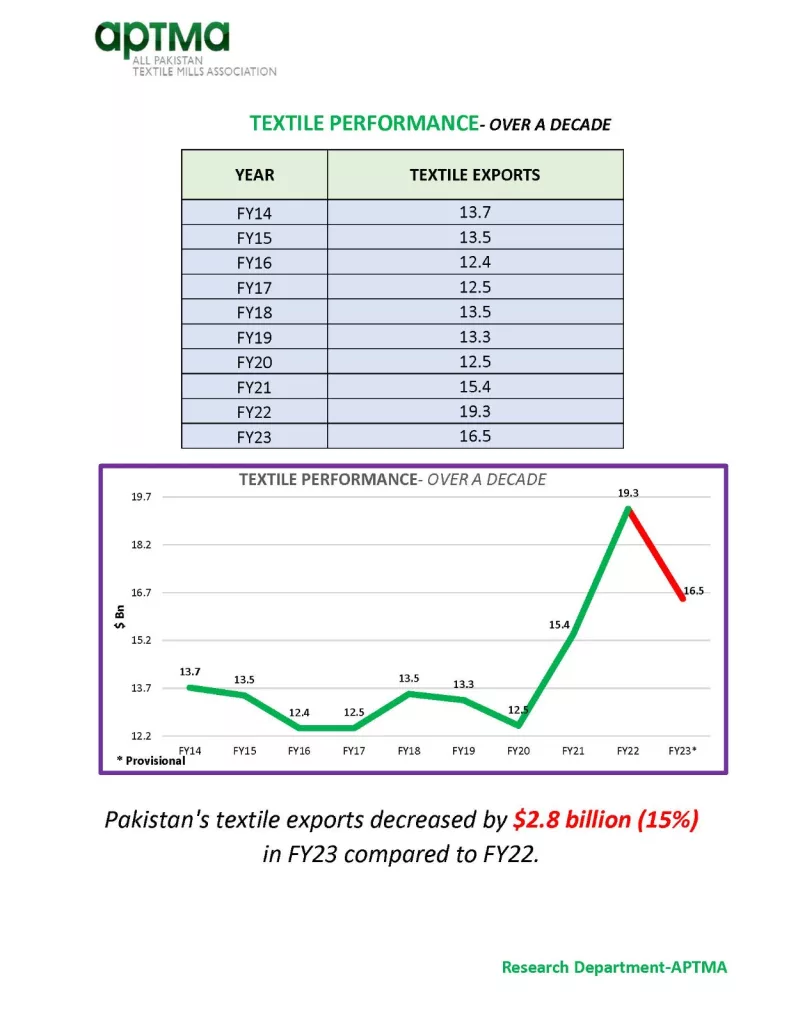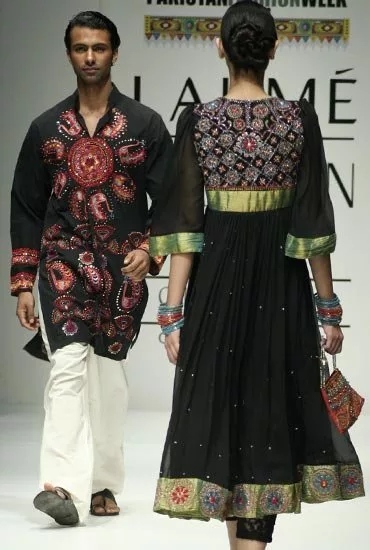Pakistan’s textile exports and clothing industry has long been a vital pillar of the country’s economy. Contributing significantly to employment and export earnings.
Textile and clothing exports account for over 61% of Pakistan’s total exports, making it a crucial sector for foreign exchange earnings. Additionally, the industry provides direct employment for about 38% of the country’s total industrial workforce, making it a vital source of livelihood for millions of people.
However, recent trends indicate a concerning decline in its credibility and market share among international buyers.
According to APTMA Textile exports decreased by 13% on June 23 compared to the corresponding year FY22. A decrease of 15% in 12MFY23 as compared to 12MFY22.
all pakistan textile mills association
Challenges Faced by the Industry:
The APTMA graphs illustrates the value of textile exports over the years, highlighting the industry’s contribution to the country’s foreign exchange earnings and its significance in international trade. However, with a downward trend in global shipments projected for the current fiscal year, it is crucial to understand the challenges faced by the industry and explore potential strategies for recovery.


a) Rising Production Costs: The textile industry in Pakistan has been grappling with rising production costs, including gas prices, electricity tariffs, wages, and compliance with international standards. These factors make Pakistani products less competitive in the global market, impacting market share and profitability.
b) Energy Crisis: Frequent power outages and an inconsistent energy supply have hampered production and efficiency in the textile sector. Reliable and affordable energy is essential for maintaining consistent production schedules and meeting buyer demands. Competitive Energy Tariff is a prerequisite for exporters to compete in the region.
c) Inadequate supply of fiber / cotton due to import policies: This lack affects the industry’s ability to function and meet delivery timelines and efficiently manage supply chains. As a result, factory shutdowns are a norm in the textile sector.
d) Climate Change: Cotton farming faces challenges due to climate change especially in the back drop of last year’s catastrophe. Read Pakistan Floods:Never Forget. However, this can change quickly with a traditional bumper crop season and a favorable climate.
e) Lack of Innovation and Design: To remain competitive, the industry needs to focus on innovation, design, and product diversification. Pakistan has traditionally been known for its quality home textiles, but it must adapt to evolving consumer demands and international trends to capture new markets.
f) Trade Barriers and Competition: Global trade barriers, such as tariff and non-tariff measures, create hurdles for Pakistani textile exporters. Moreover, fierce competition from countries like China, Bangladesh, and Vietnam, which offer lower production costs, poses a challenge to Pakistan’s market share.
Strategies for Recovery
Sustaining and revitalizing this industry is essential for economic growth, exports and job creation. Branding Fashion(adapting the mindset 1st) on innovation within textile industry may help.
READ MORE THE FUTURE OF PAKISTAN’S FASHION & TEXTILE INDUSTRY BY ASIM QURESHI
Therefore, investing in:
a) Enhancing Competitiveness: The industry must focus on reducing production costs. Through technological upgrades, efficient resource management, and sustainable practices. Encouraging investment in research and development can foster innovation and product differentiation.
b) Strengthening Value Chains: Collaborative efforts involving textile manufacturers, designers, research and development institutes.
The Textile and Apparel Industry value chain is quite different from all other industries as it involves not only process but also human emotions. It’s a beautiful combination of both art and science. Here the buyers drive the value chain by their choices.
Importance of textile and apparel value chain
This can help create value-added products that cater to international market preferences. Building strong backward and forward linkages within the industry will enhance its competitiveness and increase market share. Moreover, the need for establishing a sustainable (local) supply of Cotton and PSF through expertise in local farming cannot be ignored.
c) Government Support and Policy Reforms: The government plays a vital role in creating an enabling environment for the textile industry. Policy reforms, including the reduction of energy costs, prioritizing productivity of local farming, provision of export incentives, and facilitation of trade agreements. This can significantly improve the industry’s prospects only in the overall scheme of things.
d) Promoting Innovation + Sustainability: Embracing sustainable practices, such as eco-friendly manufacturing processes. Use of organic materials, and compliance with international labor and environmental standards. All of these measure can enhance the industry’s reputation and attract responsible buyers. In the global fashion trade where the future in sync with innovation and sustainability.
e) Market Diversification: Over reliance on a few key markets makes the industry vulnerable to fluctuations. Exploring new markets like in Africa and expanding export destinations can mitigate risks and increase resilience. For example, having experienced favorable results in the shape of the global Indian buyer for #pakistanifashion (brands) around the world. The opportunity lies in converting this (informal) buyer into the business of fashion and trade.
Read more on the blog The Future of Pakistan Fashion Industry & Textile.


Conclusion
Pakistan’s textile export and clothing industry is facing significant challenges, including loss of credibility, declining market share, and a projected downward trend in global shipments. However, with the implementation of appropriate strategies and necessary support from the government, the industry can regain its competitive edge.
If only Pakistan can learn (from the value of failure) to sustain its strength over its weaknesses.
While addressing cost-related issues, promoting innovation, strengthening value chains, and embracing sustainability is essential. Pakistan’s textile industry must reclaim its position by strategically focusing on value addition. Branding fashion may help the world to see us in a different lens.
All Image Credits : Asim Qureshi
Looking forward to your Feedback in Comments | For inquiries, please contact us on starringbrands@asimqureshi.com
- The Strategic Use of Entertainment in Nation-Building - August 23, 2024
- The Future of Pakistan:Realizing Potential, Upholding Human Rights - August 14, 2023
- The Future of Pakistan’s Fashion and Textile Industry - July 7, 2023



If only Pakistan can learn to sustain its strength over its weaknesses. Good informative piece on the challenges faced by Pakistans Textile industry. Tragic at the same time knowing this industry used to be the pillar of strength for exports and local market. Also sound advice considering your experience in marketing Pakistan fashion industry. globally
Beautifully said ” If only Pakistan can learn to sustain its strength over its weaknesses.”
Pakistani fashion has considerable demand among indian buyers I second that having attended many exhibitions over the years here in Dubai. They need to market themselves strongly. Good to know you have previously taken the lead in this regard. Hope things improve.
Excellent ! as you mention loss of credibility and declining market share in global markets one must deeply look into re branding Pakistan’s Fashion. I think you realized this 20 years back and achieved a way forward by launching Pakistan Fashion Week on the global and regional level. Wish it had been carried forward with same vision of putting Pakistan on the map rather than what it became after you left.
China is the leader in manufacutring clothing and exporting them. I think where you say about fashion is the best approach for Pakistan. Value addtion can help Pakistan make a mark in the world.
Well Done Asim Qureshi Sb, you are a good man who can do more for Pakistan Fashion & Textile Industry especially marketing internationally and help create new markets with your valuable and unique experience.
Good One Asim. Very informative and engaging.
APTMA people are always CRYING and asking for more from governments for many many years.. They never delivered on creating brands from Pakistan even though infrastructure, knowledge and skills is there also Pakistan has rich tradition of textiles and cotton. It has never truly served Pakistani Fashion in the international market.
Good read and thought process the world needs to know more of Pakistan and its rich culture especially in fashion and handicrafts. One brand can make a difference in the international market especially here in Europe.
I think with your experience you can do so much more for bringing a positive change between India and Pakistan, again.
Excellent ! Very well written your contribution to bringing change to fashion industry has no parallel
Bonjour! Asim. Nice blog. Big fashion brands are looking at Africa next do consider and someone like you have the experience. Just one or two brands can make a lot of difference.
[…] Pakistan’s fashion and textile industry has been a significant contributor to the country’s economy, employing millions of people and earning valuable foreign exchange. Textile and clothing exports account for over 61% of Pakistan’s total exports, making it a crucial sector for foreign exchange earnings. However, it is facing daunting challenges which must be addressed first. Please read the blog Pakistan’s Textile Exports:Challenges and Road To Recovery. […]